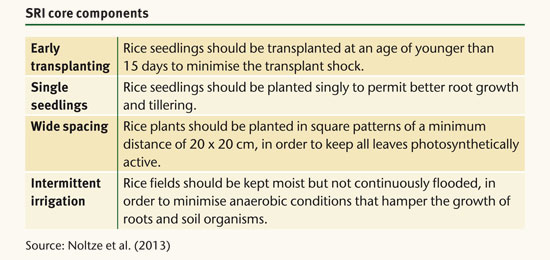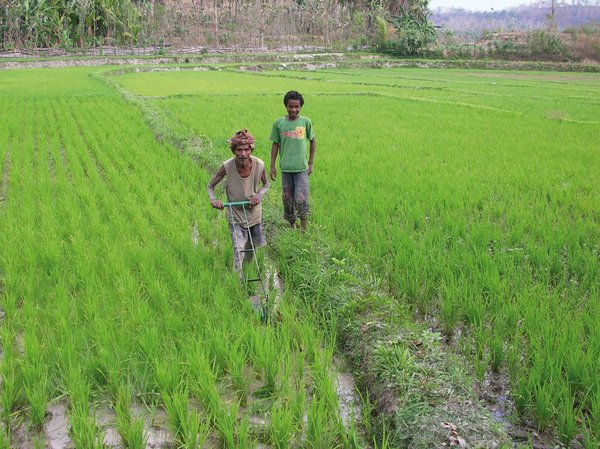 Download this article in magazine layout
Download this article in magazine layout
- Share this article
- Subscribe to our newsletter
Experience with the System of Rice Intensification in Timor Leste
Rice is the number one food crop in large parts of the developing world. This is especially true in Asia, but in Africa, too, the importance of rice is growing. Given population growth, rising demand and limited land resources, further increases in rice yields will be required. However, yield growth has slowed down recently, and additional inputs are facing diminishing returns. Moreover, rice production with high input regimes leaves a significant environmental footprint; in some regions excessive use of fertiliser, pesticides and water has led to environmental problems, including the depletion of natural resources. Heavily fertilised, continuously flooded rice fields also contribute to greenhouse gas emissions and climate change, while climate change itself is likely to impact negatively on rice production. In some regions, rice farmers are already having to cope with water scarcity and droughts. Future yield growth must hence be accomplished with less reliable water supplies, less environmental degradation and less resource depletion.
How to achieve higher yields with lower quantities of inputs is becoming the crucial question. Here we argue that natural resource management (NRM) technologies offer interesting perspectives. This is demonstrated by one concrete example, namely SRI that smallholder farmers in Timor Leste have recently started to adopt.
NRM technologies
Recently, NRM technologies have been proposed to improve the efficiency of cropping systems in a sustainable way. These technologies build on integrated agronomic principles, responding to a wide range of challenges in different environments. Prominent examples include conservation agriculture, agroforestry and organic farming, all of which have attracted considerable attention over the last few decades. NRM approaches reduce the use of external inputs by enhancing the potential of locally available resources through improved management practices. This is in contrast to many conventional technologies, such as high-yielding crop varieties, where the innovation is related to a particular input.
Unlike standardised input packages, NRM technologies involve the adaptation of practices to local conditions. As a result, best practices in one place cannot necessarily be generalised. This is especially true in smallholder agriculture due to highly diversified resource endowments and farm management options. Location-specific adaptation may result in adoption patterns and impacts that vary from one place to another. This also makes impact assessment more complicated, contributing to controversies over the potential role of NRM technologies on a broader scale. The ongoing scientific and public debate reveals that there are important knowledge gaps concerning the ramifications of NRM technologies in theory and practice.
SRI principles and components
In rice production, SRI is one of the most prominent natural resource management technologies. The aim of SRI is to contribute to higher yields with lower amounts of external inputs such as seed, water and fertiliser through better management of irrigation, soil fertility and pests. SRI is a farmer-centred innovation that originated in Madagascar in the mid-1980s. SRI methods have since been introduced in almost 50 countries, including major rice producers like India, China, the Philippines, and Vietnam.
Based on the experience from Madagascar, several SRI core components were developed, including early transplanting, single seedlings, wide spacing and intermittent irrigation (see Table below). Sometimes additional components are recommended, including organic fertilisation and regular weeding, among others. Weeding is more important in SRI than in conventional rice production, because weeds spread more rapidly under non-flooded conditions.

Adoption of SRI in Timor Leste
In Timor Leste, the System of Rice Intensification has been introduced since 2007 through a programme jointly implemented by Deutsche Gesellschaft für Internationale Zusammenarbeit (GIZ) and the Timorese Ministry of Agriculture and Fisheries. The rice sector in Timor Leste is constrained by low levels of mechanisation, insufficient irrigation and weak transport infrastructure. At the farm level, this implies shortages of rice seeds, irrigation water and chemical inputs.
To analyse SRI adoption and impacts, we conducted a survey of close to 400 randomly selected households and also collected soil samples from farmers’ rice plots. The data show that SRI adoption rates vary regionally, and that even among the SRI users partial adoption is commonplace. Partial adoption implies that farmers use SRI techniques only on part of their total rice area. In addition, different SRI components are adopted to varying degrees. Regression analysis demonstrates that socioeconomic household characteristics tend to influence SRI adoption decisions. Participation in special training programmes is an important factor, because SRI is a knowledge-intensive technology. Moreover, sufficient availability of family labour is an important determinant of adoption. SRI is relatively labour-intensive, and, especially in the early phase of adoption when farmers are experimenting with the new system, family labour cannot easily be replaced by hired labour.
However, socioeconomic characteristics alone can explain adoption only to a limited extent. Plot level characteristics also determine the use of SRI. A key factor is the availability of a technical irrigation system that allows farmers to control water levels in accordance with SRI recommendations. Water management by user groups may hinder SRI adoption, because then farmers cannot control water levels on their plots individually. Close proximity of a plot to the homestead also increases the likelihood of adoption, as this facilitates monitoring and experimenting with the new technology. Improved rural infrastructure could also help reduce the time to reach plots at larger distances. Finally, the decision to adopt SRI is influenced by soil characteristics and topography, including conductivity, loam content, and slope, which are all related to water and nutrient holding capacity. Ignoring such factors in SRI dissemination programmes may lead to unsatisfactory adoption outcomes.
Adaptation through knowledge
The analysis in Timor Leste suggests that successful adoption of SRI requires a substantial amount of experimenting with how to adapt the technology and its components to location-specific conditions. While some degree of farmer experimentation is desirable, this can be quite challenging in terms of knowledge, management time and the risk of failure. Frustrating experience entails disadoption and negative publicity for the technology as a whole. Hence, extension efforts have to be sufficiently flexible and location-specific, which requires new skills for extension agents, including experience with participatory learning.
Historically, public extension programmes have not always been very effective in developing countries. Thus, developing new cost-effective extension approaches is important. Without improved extension models, widespread and successful adoption of NRM technologies is unlikely to happen among smallholder farmers. The integration of local farmer knowledge through community-based learning and farmer-to-farmer transfer could be promising to make extension programmes more sustainable.
Yield and income effects of SRI
We also used the survey data from Timor Leste to analyse the impacts of SRI adoption on rice yields and household incomes. If one simply compares yields on SRI and conventional rice plots, the difference in our sample is insignificant. However, such a comparison can be misleading due to possible selection bias. Since farmers decided themselves whether or not to adopt the new technology, there may be systematic differences between the characteristics of adopters and non-adopters. Indeed, we find that SRI farmers in Timor Leste are those that operate under more unfavourable conditions. In other words, without SRI, they would have lower yields than other farmers. Controlling for these differences, we find that SRI adoption has a positive net yield effect of 46 per cent. This substantial gain is the average effect for the adopters. For farmers who have not adopted, switching to SRI could increase yields by an estimated eleven per cent. These findings underline that yield impacts are situation-specific, which is in line with earlier studies on SRI in different countries.
The impact of SRI on total household income is an average increase of two per cent for technology adopters. This effect is statistically significant, but lower than what one might expect when looking at the yield gains. The reason is that SRI requires more labour and management time from farmers, which has to be subtracted from other economic activities. While the revenue from rice production increases through SRI adoption, the income from other sources is somewhat reduced. It should be stressed, however, that the data refer to the early stages of SRI adoption in Timor Leste. With more experience, management time can possibly be reduced, which could lead to higher household income gains in the future.
Interestingly, when splitting up the sample by farm size, income gains for smaller farms of less than two hectares are larger than those for relatively larger farms. Household income effects of SRI have not been analysed previously in the scientific literature.
Outlook
SRI and other NRM technologies clearly have the potential to increase productivity while reducing the use of external inputs. However, they are relatively knowledge-intensive and require local adaptation, so that successful adoption by smallholders depends on proper extension programmes. Moreover, SRI requires more labour and management time, at least during the early stages of adoption. The results from Timor Leste and other countries suggest that impacts of SRI are quite situation-specific.
While SRI seems to be promising in many situations, this technology should not be seen as a substitute for other innovations, such as improved seed. There is still limited knowledge about the interactions of SRI with different rice varieties. But the highest SRI yields reported in the literature were actually achieved with high-yielding rice varieties and hybrids, suggesting that breeding and agronomic innovations are complementary. The development of sustainable production systems requires smart combinations of various technologies.
Further reading
Noltze, M., Schwarze, S., Qaim, M. (2012). Understanding the adoption of system technologies in smallholder agriculture: The system of rice intensification (SRI) in Timor Leste. Agricultural Systems 108, 64–73.
Noltze, M., Schwarze, S., Qaim, M. (2013). Impacts of natural resource management technologies on agricultural yield and household income:
The system of rice intensification in Timor Leste. Ecological Economics 85,
59–68.
Martin Noltze
German Institute for Development
Evaluation (DEval)
Bonn, Germany
martin.noltze@deval.org
Stefan Schwarze
Matin Qaim
University of Göttingen, Germany





Add a comment
Be the First to Comment